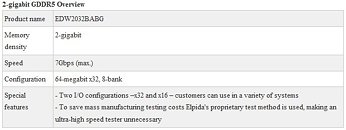Thursday, June 24th 2010

Elpida Completes Development of 2 Gb GDDR5 Memory Chips
Elpida Memory, Inc., Japan's leading global supplier of Dynamic Random Access Memory (DRAM), today announced that it had completed development of a high-density, high-speed, low-power consumption 50nm process 2-gigabit GDDR5 using copper interconnects (product name: EDW2032BABG). The new GDDR5, the first graphics DRAM designed by Elpida, was developed at the company's Munich Design Center in Germany.
Applications for GDDR (GDDR: Graphics Double Data Rate) memory devices used with GPU (Graphics Processing Unit) are found not only in such graphic processing equipment as game consoles and PC graphics cards but also in equipment that require high-performance computing for use in such areas as science and technology, physical simulation, digital image processing and video conversion. Using 2-gigabit GDDR5 in these applications can double the frame buffer size of each GPU compared with 1-gigabit memory products.As a result, the GPU can perform high-speed processing without exchanging large-volume image data with the main memory, making possible realistic PC graphics images. Also, use of 2-gigabit GDDR5 in such fields as science & technology computing and physical simulations is expected to improve system performance, as systems installed with the new graphics DRAM can handle larger amounts of data and more thread processing.
At present, Elpida is outsourcing 1-gigabit GDDR3/GDDR5 production to Taiwan-based Winbond Electronics Corporation. The company's Hiroshima Plant, however, plans to handle 2-gigabit GDDR5 production. Basing this production in Hiroshima enables Elpida to provide a more timely and flexible response to anticipated future growth in graphics DRAM demand.
Elpida plans to begin sample shipments of the new 2-gigabit GDDR5 in July 2010. Mass production is expected to get underway in the CY 2010 third quarter (July-Sept).
Applications for GDDR (GDDR: Graphics Double Data Rate) memory devices used with GPU (Graphics Processing Unit) are found not only in such graphic processing equipment as game consoles and PC graphics cards but also in equipment that require high-performance computing for use in such areas as science and technology, physical simulation, digital image processing and video conversion. Using 2-gigabit GDDR5 in these applications can double the frame buffer size of each GPU compared with 1-gigabit memory products.As a result, the GPU can perform high-speed processing without exchanging large-volume image data with the main memory, making possible realistic PC graphics images. Also, use of 2-gigabit GDDR5 in such fields as science & technology computing and physical simulations is expected to improve system performance, as systems installed with the new graphics DRAM can handle larger amounts of data and more thread processing.
At present, Elpida is outsourcing 1-gigabit GDDR3/GDDR5 production to Taiwan-based Winbond Electronics Corporation. The company's Hiroshima Plant, however, plans to handle 2-gigabit GDDR5 production. Basing this production in Hiroshima enables Elpida to provide a more timely and flexible response to anticipated future growth in graphics DRAM demand.
Elpida plans to begin sample shipments of the new 2-gigabit GDDR5 in July 2010. Mass production is expected to get underway in the CY 2010 third quarter (July-Sept).


13 Comments on Elpida Completes Development of 2 Gb GDDR5 Memory Chips
_____________________________
Antec1200 filter project
2Gb= 2048 million bits = 256 million bytes
8 bits to the byte and all that.
GB is Gigabyte
8 bit = 1 byte
So, 2Gigabits GDDR5 Memory Chips = 2,048 Megabits = 256 Megabyte per chip.
Todays HD5870 1GB version is 128MB x 8 chips total = 1024MB/1GB.
HD5870 Eyefinity version has 2GB memory from 128MB x 16 chips total = 2048MB/2GB.
So Eyefinity 2GB version consume power more than 1GB version because of more chips.
If you use 2Gb chip(256MB) you can use 256MB x 8 chips to do 2 Gigabyte memory on a card.
Less power consumption.
Note : if GPU memory width is 256-bit like 5870, it could not make 256MB x 4 for 1 Gigabyte card.
They need 8 chip for 1 card such as 256MB x 8 or 128 MB x 8 instead.
Because of each memory chip contain 32-bit width.